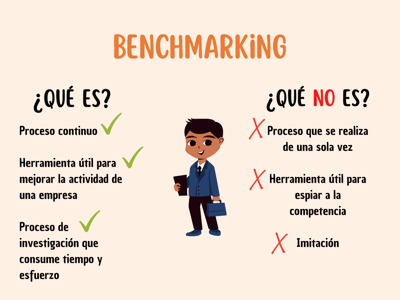Index Content
Benchmarking is the process by which a company compares its success with that of other companies. In a scenario characterised by digital transformation, it is important to keep abreast of new updates and be an interesting competitor in attracting potential customers. Thus, the main objective of benchmarking is to carry out a study of the competition with the intention of detecting possible errors in certain areas of interest. When these are detected, work is done to improve the efficiency and positioning of the brand within the industry.
This strategic marketing technique is used to measure products, services and performance by comparing them with those of other leading companies in the sector. Elements such as quality, time and cost are analysed. It helps to know the real situation of a company in the market, despite the fact that the brands being compared have a different target public. If the data are well used, a competitive advantage can be developed to overcome the benchmark companies. Benchmarking should not be confused with espionage since, with benchmarking, the aim is to carry out better practices to offer a better service, not to imitate the rest. This management tool encourages improvement in future marketing strategies.
 Benefits of benchmarking
Benefits of benchmarking
- New business objectives: Knowing the strategy of the competition and seeing why it works will be fundamental to be able to establish clear objectives. These will be measurable objectives with a high probability of success. These can be monitored and analysed to check the progress made.
- New opportunities: By benchmarking and learning about the habits of other companies, a new field of action opens up that may not have been considered before. Companies that have stagnated or are not achieving their objectives can rethink their strategy.
- Increased sales: Assessing the leading companies in the sector will help to optimise their work, which in turn will ensure increased sales.
- Increased effectiveness: Improving the efficiency and effectiveness of the company's activities is one of the purposes of benchmarking. This is achieved by identifying areas that need to improve or disappear. This technique not only focuses on the sales process, but also on the customer relationship and the use of advertising.
- Motivation: Through benchmarking, realistic targets are set. Therefore, the working environment will be favourable as employees will know that they are not pursuing an unattainable goal. Recognition programmes will ensure that employees feel valued for their efforts.
Objectives of benchmarking
- To gain knowledge about the company.
- To focus on corporate communication.
- To know the competitive level of the market.
- To focus on realistic and achievable objectives.
- Reduce costs.
- Optimise processes.
- Identify areas that are not working.
- Propose new marketing strategies.
- Understand customer needs.
Types of benchmarking
Internal benchmarking: This type of benchmarking is based on the comparison of similar processes within a company in order to improve internal operations. In other words, it compares different departments or sites within the same company. Its main benefit is the low cost and in-depth understanding of the business. However, it has little impact on profits because, being internally biased, the options for growth are limited. In addition, it encourages competition between peers of the same brand.
Competitive benchmarking: This is a study of your company and the competition against a common competitor. In other words, it is based on cooperation between two businesses to outperform the same company. It compares similar processes, enhances brand recognition and invites business partnership. It should be noted that with this type of assessment the company is confronted with misleading information and the display of its weaknesses.
Functional benchmarking: This is dedicated to comparing processes with high similarity, but from different sectors. Successful practices in different areas are known and bring new ideas. It increases the rate of improvement by focusing on quality, but it is more difficult to find similar processes in different sectors. This results in a higher investment of time.
Generic benchmarking: This model looks at different business processes and finds out how they can be implemented in a given company, even if they do not belong to the same sector. It aims to innovate from a generic view of the market. This happens, for example, when a restaurant uses a QR code for its menu as cinemas use for their tickets. Its main benefit is the broad perspective it offers. On the other hand, it is a difficult process and requires costly planning.
what is a benchmark or indicator?
Benchmarks are reference measures against which you compare the performance of your competitor and your company. Here are some of the benchmarks that are used in digital marketing:
- Customer satisfaction.
- Percentage of loyal customers.
- Pricing.
- Percentage of sales.
- Brand recognition.
5 phases to design a benchmarking process
1. Plan objectivesThis first step consists of establishing the objectives to be achieved, the company to be benchmarked against and the aspects to be improved. It is also necessary to decide how the process will be documented in order to obtain a clearer roadmap. The benchmark selected to measure the objectives can be one or several companies.
2. Gathering informationTo start benchmarking you need to collect data on how your competitors perform marketing actions and how your company does it. The data collected can be classified as primary, when it refers to the collection directly from the company, or secondary, when it is obtained from external sources. Market research, questionnaires or interviews are interesting methods to collect information.
3. Analysing the dataBy analysing the data, you can find out what is wrong with your company. The study is shown in a projection and serves to classify the problems and their causes.
4. ActOnce the data has been analysed, an action plan should be made to promote changes in your marketing strategy. In order for the process to work, these changes should be implemented and the focus should be on improving performance.
5. Monitor resultsTracking results through monitoring tools will help you to know if your objectives have been achieved and to evaluate progress to optimise future campaigns.
Examples of successful benchmarking
Starbucks: Starbucks began to lose customers in the United States because of the high price of its coffee. It was easier for customers to turn to cheaper options, even if they were of poorer quality. Starbucks benchmarked Toyota. It may seem unrelated, but it was the car company's just-in-time system that helped Starbucks regain its productivity.
McDonald's and Burger King: These fast food companies have the same objective: to have brand identity through taste and to offer fast service for a low price. Both often use the same marketing strategies to reach their target audience. For example, both include a toy in their children's menu. McDonald's conducted a benchmarking study in which it found out that Burger King successfully applied free drink refills in its stores. Subsequently, it incorporated it into its strategy and regained its position in the competition.





